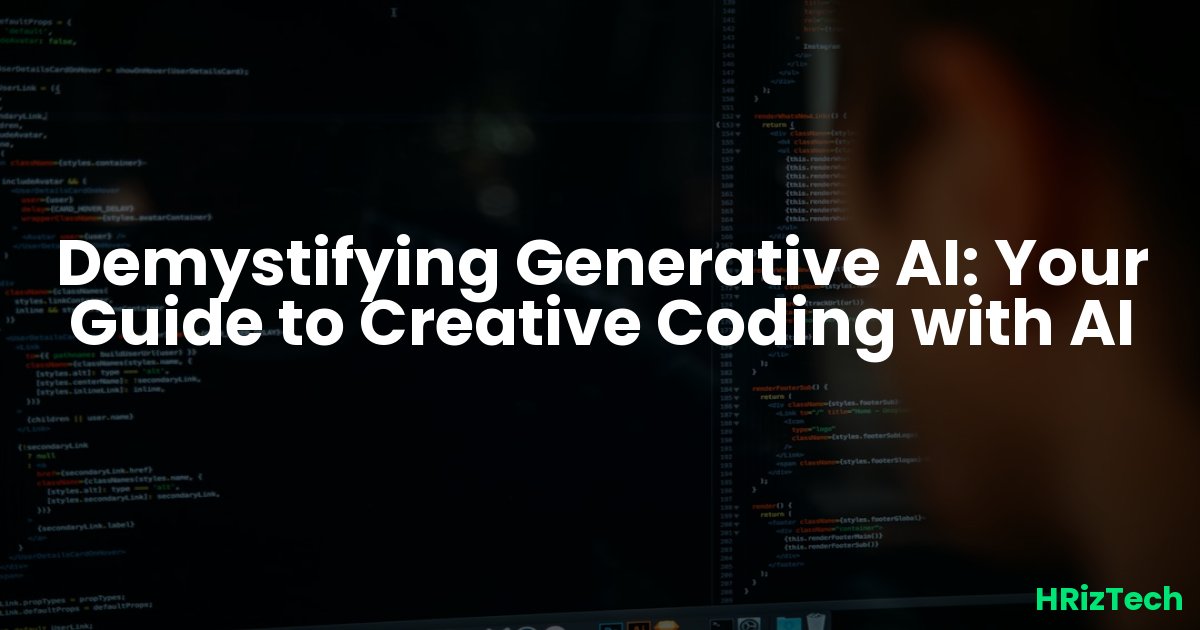Demystifying Generative AI: Your Guide to Creative Coding with AI

Demystifying Generative AI: Your Guide to Creative Coding with AI
Ever wished you could create stunning artwork, write compelling stories, or compose music without years of dedicated training? That's the magic of Generative AI, a rapidly growing field poised to revolutionize creative industries. But how do you even *begin* to understand and use this powerful technology? This guide will demystify Generative AI, showing you how to leverage its capabilities for your creative projects.
Generative AI is already making waves. A 2025 Gartner report predicts that by 2025, 30% of new drugs and materials will be discovered using Generative AI. That's not just about art; it's about transforming entire industries. Let's dive into how you can harness its power.
What is Generative AI, Anyway?
Generative AI uses machine learning algorithms to create new content. Think of it like this: instead of simply analyzing data, Generative AI *generates* it. This new content can take many forms, from images and videos to text and music. It learns from vast datasets of existing content and then uses this knowledge to produce something entirely new and original.
Unlike traditional programming, which relies on explicit instructions, Generative AI learns patterns and generates outputs based on those learned patterns. This makes it particularly useful for tasks where defining precise rules is difficult or impossible.
How Does Generative AI Work? The Magic Behind the Scenes
Understanding the Models
The core of Generative AI lies in complex neural networks, often involving deep learning techniques. These networks are trained on massive datasets, learning the statistical relationships between different elements within that data. Once trained, they can then generate new data that resembles the training data but is not a direct copy.
Common architectures include Generative Adversarial Networks (GANs) and Variational Autoencoders (VAEs). GANs involve two competing networks – a generator and a discriminator – that learn to create increasingly realistic outputs. VAEs, on the other hand, focus on learning a compressed representation of the data and then reconstructing it.
Getting Started with Generative AI: Tools and Techniques
So, how do you start building your own Generative AI projects? It's easier than you might think! Many user-friendly tools are available, removing the need for extensive coding experience.
- DALL-E 2 (OpenAI): Create stunning images from text prompts. It's incredibly intuitive and requires minimal technical skill.
- Midjourney: Another popular image generation tool accessed via Discord, known for its artistic style and community.
- Stable Diffusion: An open-source model that allows for more customization and control, perfect for those comfortable with some coding.
- Jasper.ai and Copy.ai: These AI writing assistants can help generate various content formats, from blog posts to marketing copy.
Remember to always respect copyright and ethical considerations when using Generative AI. Many tools have guidelines to help you navigate this.
Addressing Common Challenges: Overcoming the Hurdles
One common hurdle is understanding the limitations of Generative AI. While it's incredibly powerful, it's not perfect. Outputs can sometimes be nonsensical, inaccurate, or biased. Careful prompt engineering and post-processing are crucial.
Another challenge is the computational resources required to train and run some Generative AI models. This can be expensive and require specialized hardware. However, many user-friendly tools abstract away these complexities, making Generative AI accessible to a wider audience.
Generative AI and the Future: 2025 and Beyond
The future of Generative AI is bright. By 2025, we'll likely see even more sophisticated models capable of producing even more realistic and creative outputs. A 2025 Forrester report suggests that Generative AI will become increasingly integrated into various applications, from design and engineering to education and healthcare. However, cybersecurity concerns around AI-generated deepfakes and misuse will also need careful consideration.
How do you see Generative AI impacting your field in the next few years? What are you most excited about?
Conclusion: Embracing the Creative Power of Generative AI
Generative AI is more than just a buzzword; it's a powerful tool with the potential to revolutionize creativity. By understanding its capabilities and limitations, and by utilizing the readily available tools, you can unlock its creative potential in your own projects. Remember to experiment, learn from your mistakes, and most importantly, have fun!
Generative AI is transforming how we approach creative tasks, and its impact will only grow in the coming years. Mastering this technology will provide a significant competitive advantage in many fields.
What’s your favorite AI tool? Share below!
Comments
No comments yet. Be the first to comment!